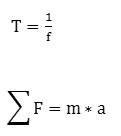Seismic Isolators and their Types
Alireza Kamrava1 *
1
Department of Environment and Cvil engineering,
Campus of Shiraz university of Technology,
Shiraz,
Iran
Corresponding author Email: A.Kamrava@sutech.ac.ir
DOI: http://dx.doi.org/10.12944/CWE.10.Special-Issue1.05
In this paper I would like to describe about what seismic isolation is., seismic isolators, their types ,how do they work? ,their advantage and disadvantage. In seismic isolator types you will read about Elastomeric bearings, Natural and Synthetic Rubber Bearings , Lead Rubber Bearings , Friction pendulum bearing, Supplymetal Damping Devices like Buckling Restrained Brace, Fluid Dampers, Visco-Elastic Dampers,Friction Dampers, Hysteretic Dampers(Yeilding Dampers).In advantage and disadvantage part you will read some tips about using seismic isolators. In conclusion you will read a review about seismic isolation and using seismic isolators.
Copy the following to cite this article:
Kamrava A. Seismic Isolators and their Types. Special Issue of Curr World Environ 2015;10(Special Issue May 2015) DOI:http://dx.doi.org/10.12944/CWE.10.Special-Issue1.05
Copy the following to cite this URL:
Kamrava A. Seismic Isolators and their Types. Special Issue of Curr World Environ 2015;10(Special Issue May 2015). Special Issue of Curr World Environ 2015;10(Special Issue May 2015). Available from: http://www.cwejournal.org/?p=10590
Download article (pdf)
Citation Manager
Publish History
Select type of program for download
| Endnote EndNote format (Mac & Win) | |
| Reference Manager Ris format (Win only) | |
| Procite Ris format (Win only) | |
| Medlars Format | |
| RefWorks Format RefWorks format (Mac & Win) | |
| BibTex Format BibTex format (Mac & Win) |
Article Publishing History
| Received: | 2014-11-31 |
|---|---|
| Accepted: | 2014-12-15 |
Introduction
Seismic isolation is a technique used to reduce the effects of earthquake ground shaking on structure, their components and protect them from damaging. In this technique we use some hardwires that I will describe later to reduce structures lateral movement(Drift).1
How do Seismic Isolators Work?
These hardwires reduce the period and acceleration of structure. So increase the frequency and reduce forces applied to floors according to Newton second law and following formulas.
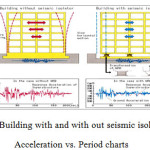 |
Fig. 1: Building with and without seismic isolators Acceleration vs. Period charts |
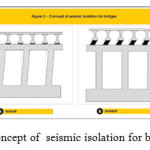 |
|
Acceleration vs. Period charts
The system decouples the building or structure from the horizontal components of the ground motion by interposing structural elements with low horizontal stiffness between the structure and the foundation. This gives the structure a fundamental frequency that is much lower than both its fixed-base frequency and the predominant frequencies of the ground motion.5 Isolators reduce the energy of structure too.
E=Ek + Es + Eh + Ev
where E is the energy induced by the seismic shaking, Ek is the kinetic energy, Es
is the elastic strain, Eh is the hysteretic damping energy, Ev is the viscous damping energy. The seismic isolation system is used in order to decrease the earthquake energy (E) acting on the structure.4
The damping by energy dissipation influences the displacement and the acceleration response as it is shown in the schemes 3a), and 3b). The local soil conditions have a great impact on the reliability of the base isolation. In stiff soil conditions a significant reduction in spectral acceleration is attained while in soft soil the adverse occurs - fig.3c)6,7
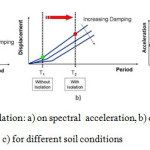 |
|
Types of Seismic Isolator Devices
There are two basic types of base isolator devices( elastomeric bearing and Friction pendulum bearing systems) and some supplementary devices for them.8
Elastomeric Bearings
These types of devices have been used, before being applied in civil engineering, to isolate vibrating machines. In their case the vibration energy flow is directed from the machine towards the foundation that has to be protected. The first use of a rubber isolation system to protect a structure from earthquakes was in 1969 for an elementary school in Skopje, Yugoslavia.9
Based on their main properties and compounds there are two sorts of elastomeric bearings: Natural and Synthetic Rubber Bearings and Lead Rubber Bearings .
By using Elastomeric bearing systems the building or structure decoupled from horizontal components of earthquake ground motion by interposing a layer with low horizontal stiffness between the structure and the foundation.8
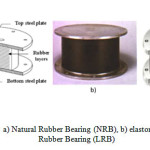 |
|
Natural and Synthetic Rubber Bearings (NRB)
As it can be seen in the Fig. 4 a), are made of alternating elastomeric layers that are made of natural rubber or neroprene. and steel shims vulcanized or glued together. The elastomeric layers provide lateral flexibility and elastic restoring force. The steel plates reinforce the bearing by providing vertical load capacity and preventing lateral bulge. A rubber cover protects the ensemble. Mounting plates connect the device to the structure above and below. Depending on the elastomeric compounds used, NRB are available as either low damping or high damping. The low damping bearings are used in conjunction with supplementary damping devices. The high damping ones are able to provide sufficient inherent damping and eliminate the need of other tools.4,8
Lead Rubber Bearings (LRB)
They are similar to the NRB, but contain a lead core - Fig. 4 c). The steel shims confine the lead plug and force it to deform in shear. Along with this deformation, dissipation of energy takes place.4
Friction Pendulum Bearing
First use of sliding bearings dates back to antique Persia (today Iran). There are evidences of pouring sand between the ground and the bearing walls of some historical structures in Iran. This would create a sliding mechanism for the structure during earthquakes.4,11 Current devices are mainly based on friction between stainless steel and Teflon®. Depending on their sliding surface geometry, two kinds of sliding bearings are distinguished: Flat Slider Bearings and Curved Slider Bearings.4 Flat slider bearings take place when horizontal forces are applied and do not have restoring ability so they use with supplementary devices that will describe later. Curved Slide Bearings act like Flat Slider Bearings but they are little different in section. They have spherical surface at bottom.
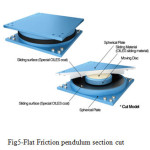 |
|
 |
|
Supply metal Damping Devices
Supply mental damping devices can be used combined with other isolators to help them restoring structures to pre-Earthquake location and can be used to help lateral forces resistance with other lateral forces resistance like moment frames.
There are many types of supplementary devices but five devices are most famous:
- Buckling Restrained Brace(BRB)
- Fluid Dampers
- Visco-Elastic Dampers
- Friction Dampers
- Hysteretic Dampers(Yeilding Dampers)
Buckling Restrained Brace(BRB)
Buckling Restrained Braces (BRBs) are a structural component useful when providing bracing for seismic or other loads. have a large ductility capacity and are designed to yield under loads without buckling. They offer robust cyclic performance and significant cost savings, compared to conventional bracing systems. BRBs have been fully codified since 2005 by the and the. Specification and design of BRBs and BRBFs (BRBs placed in concentrically braced frames) is relatively straight forward.12
The main characteristic of a BRB is its ability to yield both in compression and tension without buckling. A BRB is able to yield in compression because it is detailed and fabricated such that its two main components perform distinct tasks while remaining de-coupled. The load resisting component of a BRB, the steel core, is restrained against overall buckling by the stability component or restraining mechanism, the outer casing filled with Concrete.(Fig7)12
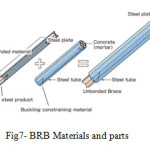 |
Fig. 7: BRB Materials and parts Click here to View figure |
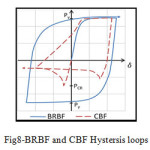 |
|
Fluid Dampers
A Fluid damper is a device which dissipates energy by applying a resisting force over a finite displacement. The damper’s output force is resistive, therefore it acts in direction opposite to that of the input motion. The value of the resisting force varies with respect to the translational velocity of damper at any point in time. The energy dissipates by means of heat transfer. The mechanical energy dissipated by the damper causes a heating of the damper’s fluid and mechanical parts, and this heat energy is harmlessly transferred to the environment by transport mechanisms, usually convection and conduction.
When the input force tries to moves piston rods, the fluid volume is reduced. This reduction in fluid volume is accompanied by the development of a restoring (Spring like) force. This prevented by the use of accumulator. (Fig:9)
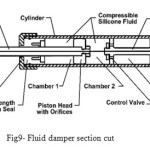 |
|
Visco-Elastic Dampers
Viscoelastic dampers consisting of viscoelstic material (VEM) bonded to steel plates. It is known that the properties vary with the ambient temperature and loading frequency.
Consequently, the viscoelastic damper is designed to operate at the ambient temperature and fundamental frequency of the structure. In addition it has been recognized that the VEM exhibits an apparent nonlinear behavior when it is subjected to high strain loading.(Fig10)
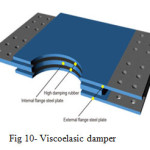 |
|
Friction Dampers
All lateral forces resistance systems like Steel braced frames, steel and concrete moment frames, steel and concrete shear walls and etc. have their own limit may be they are become stiffer or lose their beam to column connection and etc. as it had been shown in Nothridge, Tabbas, Bam and etc. earthquakes. Friction dampers are widely used to extract kinetic energy from moving body, as they have been most effective, reliable and economic. Basically these consist of series of steel plates which are specially treated to develop most reliable friction. These plates are clamped together with high strength steel bolts and allowed to slip at predetermined load(Fig 11).These are suitable for all type of construction: cast-in place and pre-constructed concrete shear walls, steel braced frames and etc. Friction dampers are not designed to move and use in moderate earthquakes and winds or floods. These type of dampers do not need repair or replace after designed earthquake and also after yielding they work to absorb winds and moderate earthquakes.
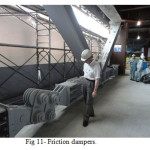 |
|
Hysteretic Dampers(Yeilding Dampers)
Hysteretic damper is intended to provide better and more reliable seismic performance than that of a conventional structure at the expense of the seismic load energy dissipation. There are four major groups of hysteretic dampers used for the purpose, namely:1-Fluid viscous dampers (FVDs) 2-Viscoelastic dampers (VEDs)3-Friction dampers (FDs)4-Metallic yielding dampers (MYDs).I described about the thir one in past and now i would like to describe about the fourth group.
Yielding Dampers are simple dampers that energy is absorbed by metallic components that yield and in this method we allow our metal components to reach yield point like using steel brace in concrete frame or steel frame.
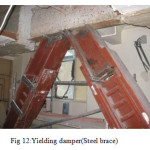 |
Fig. 12: Yielding damper(Steel brace) Click here to View figure |
Advantage and Disadvantage of Seismc Isolator Devices?
- There can be significant overlap between base isolator devices and damping devices since damping devices could be combined with base isolators, and also can be a part of damage- resistant designs.8
- Base isolation is not suitable for tall high-rise buildings.8
- Base isolation is not suitable for building on very soft soils.8
- Base isolation is most effective and suitable for low to medum rise buildings which are located on hard soils.
Conclusion
Seimic isolation is a simple technique works by using natural forces and capacity of materials like friction or liquids compression capacity. Before using seismic isolators notice the limit of using them, project and site situations. Some isolators can be used as damage resistant parts and some of them can be used as supplementary.
References
1. www.mdpi.com/journal/buildings/A Review of Seismic Isolation for Buildings: Historical Development and Research Needs(ISSN 2075-5309)
2. http://www.bridgestone.com/products/ diversified/antiseismic_rubber/method.html
3. http://www.jssi.or.jp/english/eng-sib/e-sibsource.htm
4. www.researchgate.net/profile/Ionut_Ealangi/ publication/210109277_EARTHQUAKE_ Protection_ Of_ Buildings_ By_S Eismic_ Isolation._ Devices_And_ Concepts.Pdf
5. Naeim, F., Kelly, J. M. - Design of Isolated Structures from Theory to Practice, John Wiley & Sons, Inc., Canada, 1999
6. Symans, M. D. - Seismic Protective Systems: Seismic Isolation. Instructional Material Complementing
7. FEMA 451, Design Examples, 2004
8. Symans, M. D. - Seismic Protective Systems: Passive Energy Dissipation. Instructional Material Complementing FEMA 451, Design Examples, 2004
9. canterbury.royalcommission.govt.nz/ vwluResources/ENG.ACA.00
10.Base_ Isolation_Damage-Resistant_Technologies_ P18-27.pdf 10. Naeim, F., Kelly, J. M. - Design of Isolated Structures from Theory to Practice, John Wiley & Sons, Inc., Canada, 1999
11. https://engineering.purdue.edu/UCIST/ publications/publications/Base%20 isolation%20system_Ali.pdf
12. Naderzadeh, A. - Application of Base Isolation in Iran. MENSHIN Journal, No. 63, 2009, p. 40-47
13. http://cenews.com/continuingeducation/files/ downloads/SEPDH1013.pdf (ISBN: 0 08 042822 3)
14. FLUID DAMPERS FOR APPLICATIONS OF SESMIC ENERGY DISSIPATION AND SEISMIC ISOLATION/DOUGLAS P. TAYLOR/ Eleventh World Conference on Earthquake Engineering (ISBN:0 08 042822 3)
15. http://www.iitk.ac.in/nicee/wcee/ article/11_795.PDF / Eleventh World Conference on Earthquake Engineering (ISBN: 0 08 042822 3)
16. M.L. Lai. ,P. Lu. ,D.A. Lunsford. , K. Kasai ,and K.C. Chang/ Eleventh World Conference on Earthquake Engineering(ISBN:008042822 3)
17. http://www.iitk.ac.in/nicee/wcee/article/11_497.PDF/ Eleventh World Confrence on Earthquake Engineering (ISBN:0 08 042822 3) 18. www.damptech.com
Abbreviations
- NRB=Natural and synthetic Rubber Bearing
- LRB= Lead Rubber Bearing
- BRB=Buckling Restrained Brace
- SIS=Seismic Isolation System
- AISC=American Institute of Steel Construction
- ASCE=American Society of Civil Engineers
- VEM=Visco-Elastic Material
- FVD=Fluid Viscous Dampers
- VED= Visco-Elastic Dampers
- FD=Friction Dampers
- MYD=Metal Yielding Dampers


